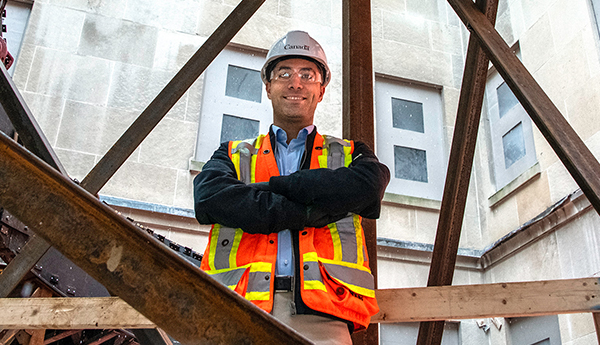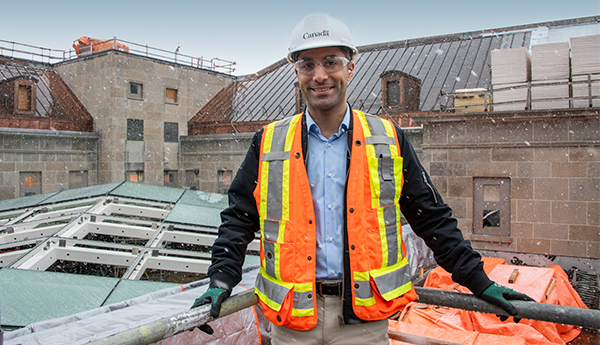Engineers find fulfilment in federal roles
In the public service, engineers can apply their skills and knowledge in ways that have a positive and lasting impact on communities across the country. At the same time, the government's extensive portfolio of infrastructure provides them with opportunities for innovation and personal growth.
As the Government of Canada's central real property manager, Public Services and Procurement Canada (PSPC) is a particularly great place for engineers to work.
Below, 2 engineers describe their experiences.
Michael Nassar joins the department through co-op programs
"I've always liked math and science," says Nassar. "In high school, I really enjoyed projects where we built a bridge, for example, and then tested how much weight you could put on before it failed. That's why it was natural for me to go into engineering." During his studies at the University of Ottawa, Nassar completed several co-op terms in various federal departments before accepting a position with PSPC.

"I went from working at a landfill and with National Research Council Canada to the job I do now, which is very different," Nassar explains. "In my current role, where I've been for 5 years, I'm contributing to the rehabilitation of important heritage sites like the West Memorial Building and the Memorial Colonnade, which connects the East and West Memorial Buildings in downtown Ottawa. It’s a monument to honour those who served in the Second World War. It's amazing to be part of the transformation of these historic assets."
The projects in the government differ from one another as much as Nassar's daily tasks, so there's never a dull moment. "I do mainly project management right now. I review design documents, requests for information, as well as change orders to make adjustments to projects during construction. That means collaborating with project partners to confirm the change makes sense and fits our budget and schedule."

While he's happy to venture into project management, Nassar notes that he has been able to satisfy his technical engineering interests at PSPC as well. "We have a centre of expertise with engineers in every specialty. I've sought their advice many times to address technical issues we've encountered on a project." For example, his team discovered that a significant number of the concrete beams in the West Memorial Building had less steel in them than expected, and he worked with the centre of expertise to find a solution to reinforce the beams. Through these interactions on technical matters, Nassar has gained the relevant work experience required to obtain his professional engineer's licence.
According to Nassar, the compelling projects and array of engineering pathways to explore are the key benefits of a PSPC role. "In the private sector, you may have a chance to work on big projects, but you are usually limited to a single engineering discipline. At PSPC, you're involved in all aspects of the projects."
Beyond the scope it offers, PSPC has a culture of mentorship and possibilities for advancement. "I've benefitted from a lot of guidance and increasing responsibilities, which has allowed me to learn and gain new skills," says Nassar. "This is while taking advantage of a work-life balance that's rare in the industry."
Ryan Tannahill comes to the department from the private sector
"I initially aspired to be an architect," says Tannahill. "But since I lacked artistic abilities, still wanted to build stuff and excelled in math, it made sense to choose engineering." After completing a degree in civil engineering at Carleton University, she landed a position with construction services firm EllisDon.

Tannahill was in the private sector for 4 years when, ready for a change, she joined PSPC in 2020 and embarked on a diverse and exciting roster of projects. "I led and delivered the first rapid modernization project to fit up a federal office, as part of a national workplace transformation initiative," she remarks.
Tannahill was asked if she wanted to continue with these projects or try her hand at others. "It was great to have a choice. I opted to broaden my horizons and go on another adventure." She was put in charge of a project on the "opposite end of the spectrum" from her previous work: a sewer system investigation at the Tunney's Pasture site, a campus of federal buildings in the National Capital Region (NCR). "My team assessed components and critical areas to determine how to extend the system's service life."
Tannahill worked on the Tunney's Pasture redevelopment project until January 2024. Her role involved managing the design of the roads and infrastructure, as well as engaging with the City of Ottawa and the public. "It was exhilarating to see the big picture, rather than just a small slice of the pie," she says.
In early 2025, Tannahill had the opportunity to complete an assignment on the 719 Heron Road project. This project aims to deliver general office space for the Shared Services Canada Integrated Enterprise Command Centre in the NCR, which will monitor information technology operations across 43 federal organizations. "I think this highlights the great opportunities to move around within the government and apply your skills to urgent or specialized projects," she adds.

Tannahill is quick to point out that government engineers also have many avenues to enhance their skills. "The talent here is amazing. We have all kinds of specialists you can consult to get exposed to their way of thinking." That's on top of formal education. The government encourages continued learning. "PSPC offered a training course that helped me prepare and study for the Project Management Professional designation. Last October, I ultimately passed my exam 'Above Target' in all categories," she concludes, "with a healthier approach to juggling work and private life than I've seen elsewhere."
As a female engineer, Tannahill says the support in the government is unparalleled. "There are many top-notch women in engineering here. The private sector may be in the vanguard in some aspects, but in terms of equality in this field, the government is leading and the private sector is catching up."
To learn about the people, projects and services at PSPC, read more articles about us on Our stories.